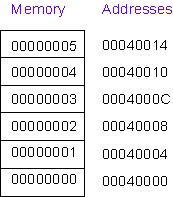Setting up the Base Register

The first instruction of the answer expresses minus eight using 16-bit two's complement. This is the bit pattern that is actually contained in the machine instruction. This is awkward to read and to calculate. The second instruction uses signed decimal notation to specify minus eight. The assembler translates this assembler instruction into exactly the same machine instruction as the first assembler instruction.
By using a 32-bit
base register and an offset a 32-bit
lw or
sw instruction
can reference memory.
But how does the base address get into the base register?
This is where the lui
(load upper immediate) instruction is useful.
It copies its 16-bit immediate operand
to the upper two bytes of the designated register.
lui t,const # upper two bytes of $t <-- two byte const
# lower two bytes of $t <-- 0x0000
Sometimes this is all that you need.
For example,
say that
memory is as in the picture,
and that you want to load the word
at 0x00040010 into $12.
The lui
instruction can set up the base register: